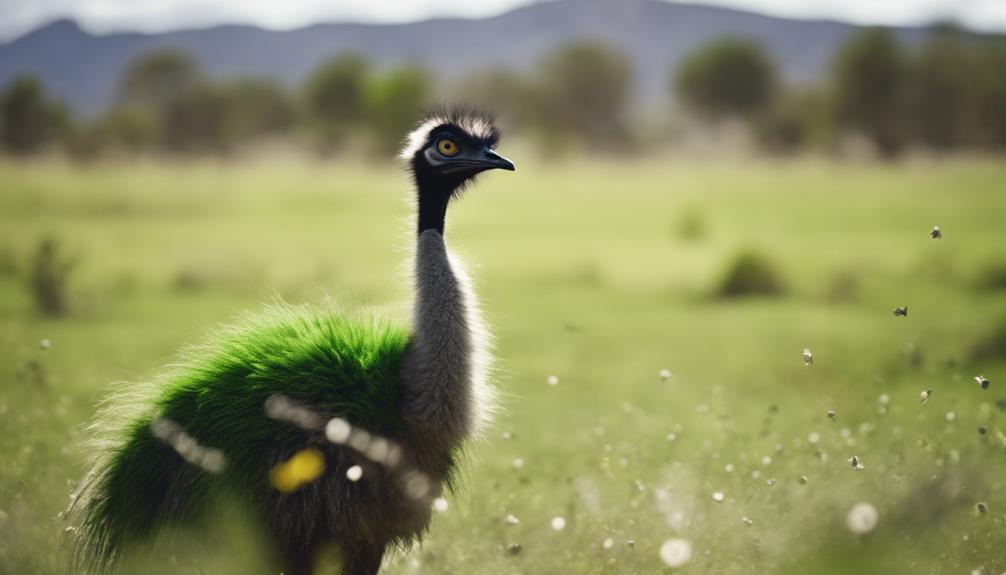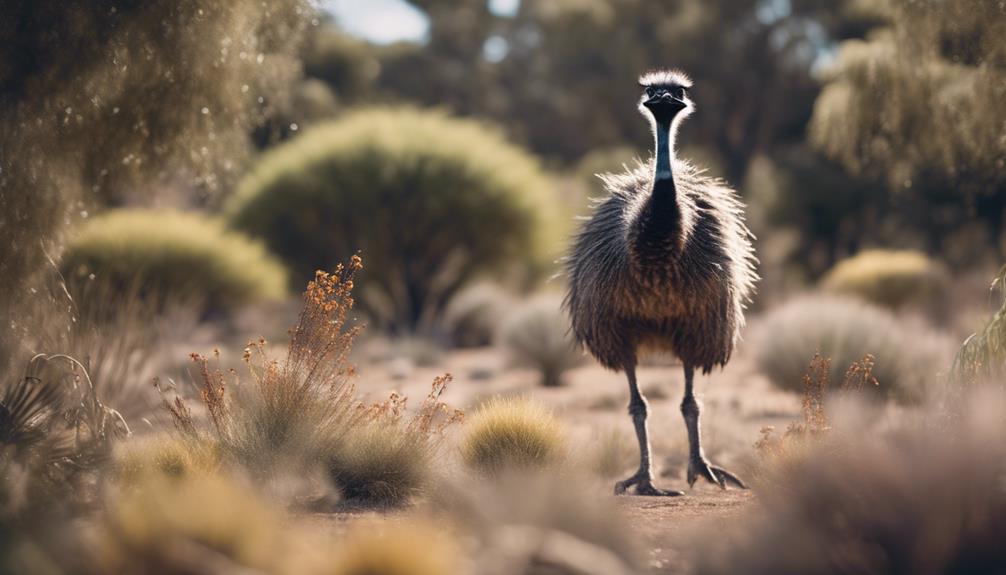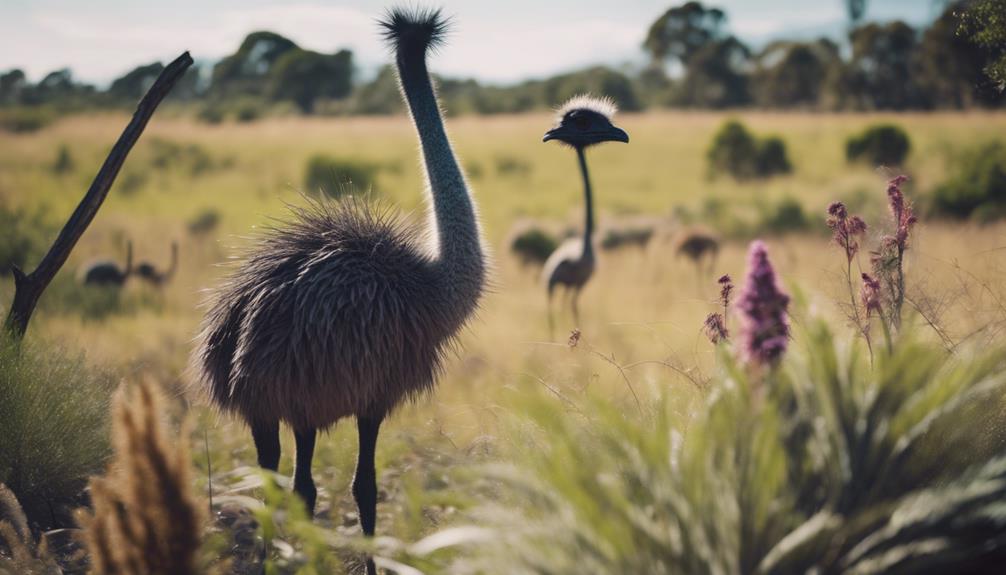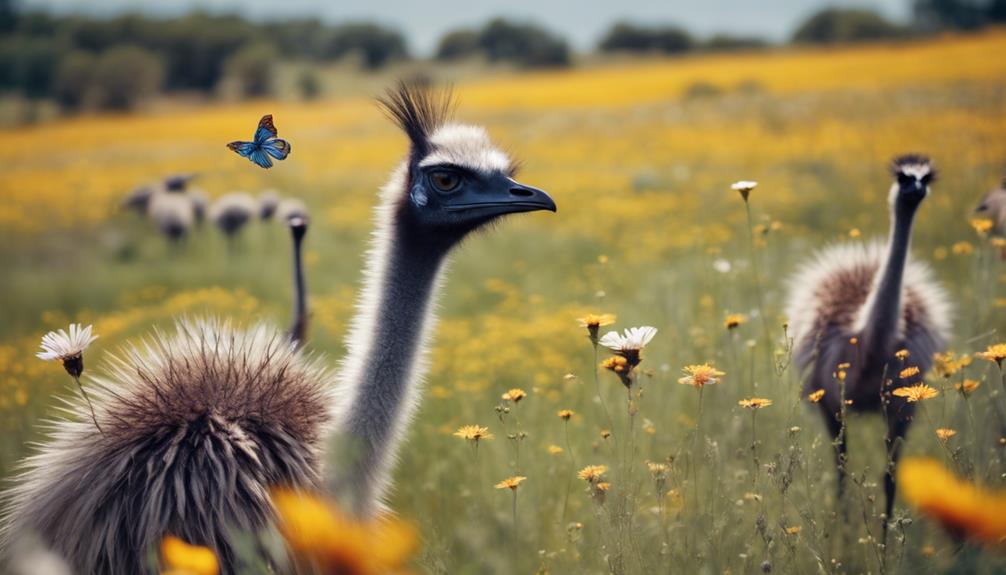
Emus play a rather understated yet crucial role in the intricate web of biodiversity and ecosystem health. Their presence in the ecosystem initiates a series of interconnected benefits that ripple through various aspects of the environment.
From enhancing seed dispersal to influencing predator-prey dynamics, the contributions of emus go beyond what meets the eye. Understanding their impact sheds light on the delicate balance of nature and the intricate dance of life in the wild.
Key Takeaways
- Emus play a crucial role in seed dispersal, enhancing plant diversity.
- Their foraging behavior influences plant competition and community structure.
- Emus aid in nutrient recycling and promote soil fertility.
- They contribute to ecosystem resilience by maintaining biodiversity and supporting vegetation regeneration.
Role in Seed Dispersal

Emus actively contribute to biodiversity through their crucial role in seed dispersal, aiding in the propagation of plant species across various ecosystems. Their unique ability to consume a wide variety of fruits and seeds plays a significant role in seed dispersal efficiency. Emus travel over vast distances in search of food, inadvertently ingesting seeds that adhere to their feathers and skin. As they roam, these seeds are dispersed across different landscapes, promoting plant diversity and colonization in new areas.
The ecological implications of emus' seed dispersal can't be understated. By transporting seeds to new locations, emus help plants establish populations in areas where they may not have been able to reach otherwise. This process contributes to the resilience of ecosystems, as a diverse array of plant species can better withstand environmental changes. Emus act as essential agents in the dispersal of seeds, fostering the growth and sustainability of plant communities in various habitats.
Impact on Plant Diversity
Playing a pivotal role in ecosystems, emus significantly influence plant diversity through their seed dispersal activities. Emus aid in plant competition dynamics by dispersing seeds across varied habitats as they forage, contributing to the establishment of diverse plant species. Through emu browsing, certain plant species are selectively favored, while others face reduced pressure, thus impacting species richness within the ecosystem. Emus play a crucial role in shaping the plant community structure by influencing the distribution and abundance of different plant species through their foraging patterns.
Emu foraging behavior not only affects the plant diversity directly consumed by them but also indirectly influences surrounding vegetation. By consuming specific plants, emus create opportunities for other plant species to thrive, thus enhancing overall plant diversity. Additionally, emus can act as agents of seed dispersal for a wide range of plant species, aiding in the colonization of new areas and promoting genetic diversity within plant populations. Emus, through their foraging and seed dispersal activities, play a vital role in maintaining and enhancing plant diversity within their ecosystems.
Contribution to Soil Health

Contributing to soil health, the impact of emus' activities on nutrient cycling and soil structure is a critical aspect of their role in ecosystem dynamics. Emus play a vital role in enhancing soil health through their foraging behavior and movement patterns. By consuming various plant species, emus aid in nutrient cycling as their droppings enrich the soil with essential elements. Moreover, their constant movement prevents soil compaction, promoting better water infiltration and aeration, which are crucial for a healthy soil ecosystem. Emus inadvertently stimulate microbial activity in the soil through their scratching behavior, further enhancing nutrient availability for plant growth.
| Nutrient Cycling | Microbial Activity | Soil Compaction |
|---|---|---|
| Emus aid in the recycling of nutrients in the soil through their feeding habits. | Emus' activities promote microbial diversity and enhance soil fertility. | Emus' movement helps prevent soil compaction, allowing for better root growth and water infiltration. |
Influence on Insect Populations
When exploring the influence of emus on insect populations, their foraging behavior reveals a complex interplay within the ecosystem dynamics. Emus, through their feeding habits and movement patterns, significantly impact insect population dynamics. Here's why this matters:
- Emu Foraging: Emus have a selective foraging behavior, targeting specific insects over others. This selective feeding can lead to fluctuations in insect populations, affecting the overall ecological balance.
- Insect Population Dynamics: The presence of emus can influence the abundance and distribution of insects in their habitat. This, in turn, can have cascading effects on various trophic levels within the ecosystem.
- Ecological Balance: The interaction between emus and insects plays a crucial role in maintaining the delicate balance of insect populations. Emus act as both consumers and regulators, shaping the dynamics of insect communities.
Understanding the intricate relationship between emus and insects sheds light on the broader impact these flightless birds have on ecosystem health and biodiversity.
Support for Predator-Prey Dynamics

Emus actively participate in supporting predator-prey dynamics within their ecosystem through their foraging behavior and interactions with various prey species. Their foraging behavior plays a crucial role in maintaining a balance between predators and prey. Emus exhibit predator avoidance tactics by staying alert and vigilant, which not only benefits their own survival but also influences the behavior of other prey species in the area. Through selective prey choices, emus indirectly impact the population sizes of different prey species, thus affecting the overall predator-prey dynamics.
Additionally, emus employ specific foraging behaviors and hunting strategies that contribute to the regulation of predator-prey interactions. Their ability to cover large areas while foraging allows them to disturb potential predators, altering the hunting success rates of these predators. By selecting certain prey over others, emus indirectly influence the distribution and abundance of prey species, further shaping the dynamics between predators and prey within their ecosystem. This intricate web of interactions highlights the significant role emus play in supporting the delicate balance of predator-prey dynamics.
Connection to Habitat Restoration
Their impact on habitat restoration efforts is evident through the symbiotic relationships emus establish with native plant species in their environment, fostering biodiversity and ecosystem resilience. Emus play a crucial role in habitat restoration by:
- Seed Dispersal: Emus aid in the dispersal of seeds through their consumption of fruits and plants, helping in the germination of native vegetation crucial for habitat restoration.
- Soil Aeration: Their foraging behavior involves scratching the soil, which enhances soil aeration and nutrient cycling, benefiting the growth of native plants.
- Fire Prevention: Emus reduce the risk of wildfires by consuming dry grasses and creating firebreaks, aiding in the maintenance of healthy ecosystems.
Utilizing emus in habitat restoration techniques and conservation strategies can lead to more sustainable and effective restoration efforts. Their presence not only aids in the recovery of degraded habitats but also promotes the establishment of diverse plant communities, contributing to overall ecosystem health and resilience.
Relationship With Native Flora

The intricate interactions between emus and native flora showcase the significant influence these birds have on the composition and dynamics of plant communities within their habitat. Emus play a crucial role in pollination patterns, particularly for various flowering plants in their environment. As emus forage for seeds and fruits, they inadvertently transfer pollen from one plant to another, aiding in the fertilization process and contributing to genetic diversity within plant populations.
Moreover, emus also play a vital role in plant regeneration. Their feeding behavior, which involves consuming a wide variety of plant species, helps in seed dispersal. By ingesting seeds and then dispersing them across different locations through their droppings, emus facilitate the germination and growth of various plant species. This process not only enhances the overall biodiversity of the ecosystem but also supports the establishment of new plant populations in different areas, contributing to the resilience of native flora communities.
Emus' interactions with native flora underscore their significance in shaping the plant composition and distribution in their habitat.
Importance in Ecosystem Resilience
In the context of ecosystem dynamics, the role of emus in promoting resilience through their interactions with native flora is paramount. Emus play a crucial part in enhancing ecosystem resilience through various adaptation strategies that aid in coping with environmental changes, particularly those induced by climate change. Understanding the significance of emu behavior, such as their social interactions and reproductive patterns, provides valuable insights into how these large birds contribute to the overall health and stability of ecosystems.
- Emu foraging habits help maintain plant diversity and distribution.
- Their movement patterns assist in seed dispersal, promoting vegetation regeneration.
- Emus' selective grazing behavior can influence the composition of plant communities, fostering resilience against disturbances.
Effect on Vegetation Structure

Playing a significant role in shaping vegetation structure, emus' foraging behaviors directly impact the composition and distribution of plant communities within their habitats. Emus are known to be selective grazers, preferring certain plant species over others, which leads to alterations in habitat structure and plant diversity. Their grazing impact on vegetation structure can be observed through changes in plant height, density, and species composition within the ecosystem. Emus play a crucial role in maintaining a balanced habitat structure by preventing the dominance of specific plant species and promoting overall biodiversity.
| Plant Height | Plant Density | Species Composition |
|---|---|---|
| Varied by grazing intensity due to selective feeding habits | Influenced by the removal of certain plant species | Shifts as emus favor specific plants over others |
Emus' grazing activities have a direct influence on the habitat structure by shaping the physical characteristics of the vegetation and determining the availability of resources for other organisms within the ecosystem. Their impact underscores the intricate relationship between herbivores and plant communities in maintaining ecosystem health and balance.
Significance in Food Web Stability
Emus significantly influence food web stability through their foraging behaviors and interactions with plant communities in their habitats. These large flightless birds play a crucial role in maintaining ecological balance by shaping trophic interactions within their ecosystems. Here's how they contribute to food web stability:
- Seed Dispersal: Emus aid in seed dispersal by consuming a variety of fruits and seeds, which they then spread across different areas through their droppings. This helps in the regeneration of plant populations and promotes biodiversity.
- Herbivory: As herbivores, emus feed on a diverse array of plant species, which can control the growth of certain plants and prevent any one species from dominating the ecosystem. This selective feeding behavior influences plant community composition and structure.
- Predator-Prey Dynamics: Emus also serve as both predators and prey in their food web interactions. By preying on insects, small vertebrates, and even small mammals, they help regulate lower trophic levels, contributing to the overall stability of the ecosystem. This intricate web of trophic interactions underscores the significance of emus in maintaining the delicate balance of their habitats.
Link to Pollination Processes

Facilitating pollination processes, emus contribute to the reproductive success of various plant species in their ecosystems through their interactions with flowering plants. Emus, through their foraging behaviors, inadvertently aid in pollination by promoting habitat connectivity and increasing floral abundance. As emus move through their habitat in search of food, they interact with a variety of plant species, transferring pollen from one flower to another. This interaction enhances pollination effectiveness by ensuring that pollen is carried over distances, increasing the genetic diversity within plant populations.
Emu foraging patterns play a crucial role in shaping the plant community structure and enhancing ecosystem health. By creating pathways through their movement, emus enable pollinators to access a wider range of flowers, leading to increased pollination rates and plant reproduction. The diverse diet of emus also contributes to their effectiveness as pollinators, as they visit a wide array of plant species, inadvertently aiding in the reproduction of multiple plant populations. Overall, emus serve as important contributors to the pollination processes within their ecosystems, highlighting their significance in maintaining biodiversity and ecosystem functioning.
Implications for Overall Biodiversity
The impact of emus' role in pollination processes extends beyond individual plant species, as their contributions have broader implications for overall biodiversity within their ecosystems. Emus play a crucial role in maintaining species interactions and ecological balance within their habitats. Their foraging behaviors not only aid in pollination but also help disperse seeds, influencing plant diversity and distribution.
Emus contribute to the ecological balance by promoting the growth of various plant species through their seed dispersal activities. Their presence helps in maintaining species interactions within the ecosystem, fostering a healthy and diverse community of plants and animals. Emus can also aid in habitat restoration efforts by dispersing seeds of native plants, which is particularly important in areas affected by habitat fragmentation.
Understanding the significance of emus in these processes is vital for developing effective conservation strategies that aim to preserve overall biodiversity and ecosystem health. By recognizing their role in maintaining ecological balance, we can implement measures to protect these iconic birds and the habitats they inhabit.
Frequently Asked Questions
Do Emus Have Any Negative Impacts on the Environment or Other Species in Their Ecosystem?
You might wonder if emus have negative impacts on their environment. They can disrupt ecological balance by overgrazing and nesting, affecting vegetation and other species. Understanding their role in the ecosystem is crucial for conservation efforts.
Can Emus Help Control Invasive Species in Their Habitat?
Emu behavior plays a vital role in invasive species management. They can help control invasive plants by consuming them, promoting the growth of native vegetation. This behavior aids in restoring ecosystem balance and preserving biodiversity.
How Do Emu Populations Respond to Changes in Their Environment, Such as Deforestation or Climate Change?
As environmental changes like deforestation or climate shifts occur, emu populations display remarkable adaptability. Emu behavior and population dynamics reveal a capacity to adjust nesting habits, foraging patterns, and migration routes, ensuring survival amidst shifting landscapes.
Are There Any Conservation Efforts in Place to Protect Emus and Their Role in Biodiversity?
In protecting emus, conservation efforts focus on habitat preservation, population monitoring, and research initiatives. By studying emu behavior and ecological roles, scientists can better understand their importance in biodiversity and implement strategies for long-term conservation success.
Do Emus Have Any Cultural or Economic Significance in the Regions Where They Are Found?
You might wonder about emus' importance beyond conservation. In regions they inhabit, emus hold cultural and economic value. Their significance in ceremonies, traditional practices, and tourism contributes to local identity and livelihoods.
Conclusion
As you observe the emus roaming through the Australian landscape, consider the intricate web of connections they weave. From dispersing seeds to shaping vegetation structure, these large birds play a crucial role in maintaining biodiversity and ecosystem health.
Imagine a world where emus are absent, and the delicate balance of nature is disrupted. Embrace the significance of these majestic creatures in sustaining the intricate tapestry of life around us.




